Passive cooling technologies such as heat sinks are often insufficient. Thermoelectric coolers address thorny issues such as size constraints and high temperature ratings.
Andrew Dereka, Laird Thermal Systems
The use of thermal cameras
by government and private security agencies to
reduce crime or improve public safety has significantly increased. Closed-circuit television (CCTV) and internet protocol (IP) security cameras can be found in cities, outside hotels and retail stores, and around entertainment venues, stadiums, and other commercial and industrial properties.
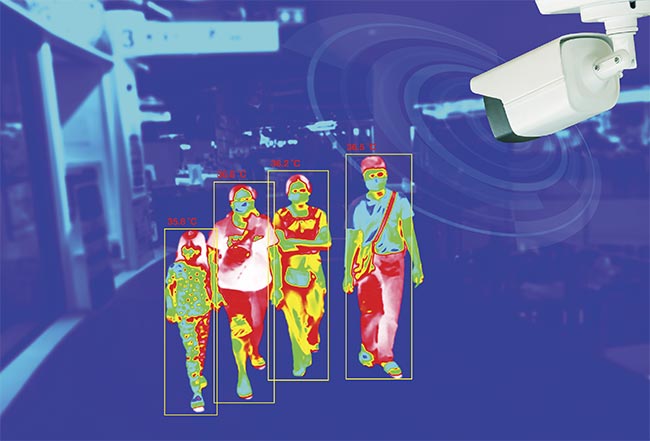
IR sensor cameras require active cooling to minimize thermal noise and maximize image resolution. Courtesy of Laird Thermal Systems.
Thermal cameras using infrared sensing are often utilized to improve facility and border security at night. Most recently, thermal cameras have been implemented as a security and safety measure to detect people’s body temperatures in the fight against COVID-19.
According to MarketsandMarkets, the global video surveillance market size is expected to grow from $45.5 billion in 2020 to $74.6 billion by 2025. This growth is driven by increasing concerns about public safety and security, the growing adoption of IP cameras, and rising demand for wireless and surveillance cameras.
Global Market Insights reports that the IP camera market size alone was valued at over $8 billion in 2018 and will grow at a compound annual growth rate (CAGR) of 14% between 2019 and 2025. The global industry shipments are expected to exceed 100 million units by 2025.
The market research company also reports that the infrared camera market size exceeded $6 billion in 2019 and is set to grow at 7% CAGR between 2020 and 2026.
Application background
Surveillance cameras use a variety of optoelectronic technologies, all of which require temperature stabilization to achieve optimal performance. Digital security cameras use two main types
of imaging sensors: charge-coupled device (CCD) and complementary metal-oxide semiconductor (CMOS) sensors. Both types convert photons into an electrical charge using an intricate 2D array of photodetectors (pixels). These individual buckets of charge are then amplified and digitized to create
the digital image. The difference between the two is how and where this process is accomplished.
Many security cameras are now implementing thermal imaging technology for detection at night. These cameras create an image using infrared radiation similar to the way a common camera forms an image using visible light. Instead of the 400- to 700-nm range of a visible light camera, infrared cameras are sensitive to wavelengths from ~1000 nm (1 μm) to ~14,000 nm (14 μm). Thermal imaging cameras use focal plane arrays that respond to longer infrared wavelengths. Some smart thermal cameras include powerful video processors that have access to the raw thermal video as it leaves the imager, allowing for more accurate detection. Advanced video processing also gives thermal cameras extended range and coverage, enabling them to detect human-size targets at ranges exceeding 600 m. Thermographic cameras can be broadly divided into two types: those with cooled infrared image detectors and those with uncooled detectors. Cooled detectors exist to maximize detection performance and viewing range.
3D cameras enable the perception of depth in images to replicate three dimensions, as experienced through human binocular vision. Some 3D cameras use two or more lenses to record multiple points of view, while others use a single lens that shifts positions. While 2D camera inspection detects or differentiates appearance or dimension based on shade data, 3D inspection incorporates height information, or xyz coordinates. Utilizing xyz coordinate data makes it possible to obtain volume and sectional area information. 3D inspection detects minute flaws that look similar to patterns on the target, which would be difficult to differentiate with conventional 2D imaging. As 3D camera technology evolves, the number of applications increases. 3D cameras are commonly used in robotic positioning, automation inspection, and character recognition for manufacturing and testing applications, and they are now being introduced to sports stadiums and entertainment venues to improve attendee experience.
Thermal challenges
No matter the camera technology implemented, it is critical that the operating temperature of sensitive imaging components is maintained below the maximum limit during use to ensure high-quality images. An IR sensor in surveillance cameras, for example, captures infrared light to measure radiation (heat) in the target object and converts it into a visual image.
To obtain maximum image quality, IR sensors must be cooled to subzero temperatures to minimize thermal noise, which is the difference between the target object and its surrounding environment. Thermal noise will disrupt and distort the image quality. Passive cooling technologies, such as heat sinks and fans, are often insufficient for cooling thermal cameras because they cannot cool below the ambient temperature. Next-generation thermoelectric coolers offer active thermal management solutions that meet the size constraints and high temperature rating required for optoelectronics implemented in thermal cameras.
Engineers can face a variety of challenges when designing thermal cameras, including thermal noise, size constraints, lack of airflow, and outgassing.
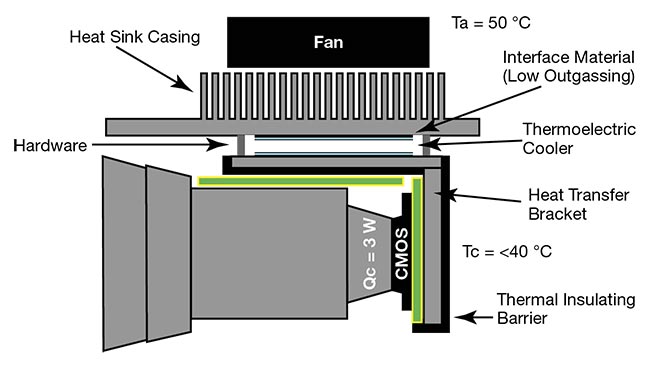
All surfaces at temperatures below dew point require protective exteriors to prevent moisture from forming on sensitive camera components. To avoid outgassing, using interface material with low outgassing characteristics is recommended. Ta: ambient temperature; Tc: cold-side control temperature that is not to exceed 40 °C; Qc: the cooling requirement, which is the rate of heat energy (measured in watts) to be removed from the device or enclosure at the cold side of the thermoelectric cooler. Courtesy of Laird Thermal Systems.
Traditional CCTV and IP outdoor cameras operate efficiently at temperatures up to 50 °C, but performance degrades as the temperature increases beyond this limit. Infrared cameras also require operating temperatures below 35 °C before imaging accuracy is affected. Outdoor camera applications may see operating temperatures as high as 90 °C due to the direct exposure to sun and heat generated by surrounding components in a compact form factor.
To obtain maximum image quality, IR sensors must be cooled to subzero temperatures to minimize thermal noise, which is the difference between the target object and its surrounding environment.
Depending on the imaging requirements, cameras may contain several CMOS sensors to enhance resolution or capabilities. For example, new 3D cameras have four CMOS sensors to generate high-quality 3D images. The internal power supply for more intricate 3D camera systems can generate more than 60 W of heat. Add in solar radiation, and the outdoor 3D camera components are tasked with operating well above their thermal temperature limits. The camera system must be cooled to minimize heat generation, with priorities given to cooling each CMOS sensor
to below its thermal tolerance in order to optimize image quality. This requires a cooling solution with enough cooling capacity to efficiently cool four sensors and dissipate heat away from all sensitive electronics into the ambient environment.
Thermal cameras are extremely sensitive to thermal noise. Since thermal cameras detect radiated heat, any heat from passive components themselves makes it harder to capture images. Thermal management systems must quickly dissipate heat away from the internal camera components, including the sensor and video processors. High-functioning thermal management systems enable IR cameras to detect thermal energy with an accuracy as fine as 0.025 °C.
The trend toward miniaturization of cameras is another factor that affects the heat load. To increase capabilities and functionality, modern security cameras feature more electronics in smaller form factors. Space constraints can negatively affect air flow while increasing the heat flux density. Limitations to proper airflow result in an inefficient thermal design that can limit cooling to above ambient, and this temperature may be above the image sensor’s maximum operating temperature limit. Cooling components, such as thermoelectric devices, can also add heat to the heat rejection path, requiring a heat exchanger that has more capacity to dissipate heat into the air environment. It is important to consider airflow that sufficiently dissipates heat to reduce the thermal resistance of the hot-side heat exchanger. Fans or liquid heat exchangers add costs and require space within an already space-constrained design, which can prove challenging.
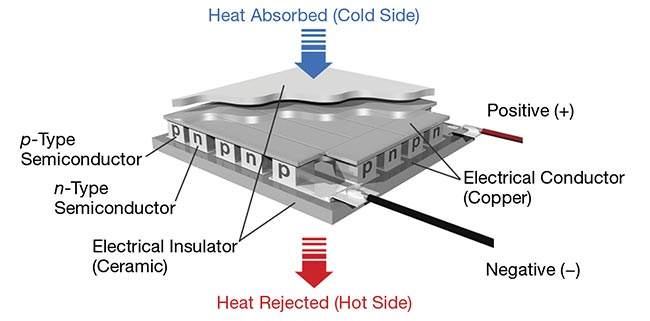
Utilizing the Peltier effect, thermoelectric coolers efficiently dissipate heat from sensitive camera components. Courtesy of Laird Thermal Systems.
Also affecting airflow are camera
designs that completely seal the camera components. This is done to enable the camera to withstand outside elements such as water or fluids and dust or dirt. Completely sealed cameras pose a significant challenge to routing heat out of the enclosure and away from thermally sensitive components. Most often, the enclosure must feature a conduction path, such as a cold plate, that conducts heat through a heat sink or heat pipe to transfer heat.
The process of cooling vital components can result in surfaces that go below dew point, which creates condensation. Surfaces exposed to temperatures below dew point will develop unwanted and potentially harmful moisture. Creating protective exteriors to prevent moisture, condensation, and the ingress of other outside contaminants is critical in protecting sensitive
camera electronics. Outgassing must also be avoided at all costs, as it can contaminate the security camera lenses. Minimizing materials that could potentially outgas, such as interface materials or insulation on lead wires, must be considered during the design phase.
Standard heat sinks cannot cool below ambient and do not offer temperature control as a standalone unit to meet thermal camera requirements. Active thermoelectric devices such as thermoelectric coolers have been used in conjunction with passive heat exchangers to offer spot cooling of camera sensors. Thermoelectric coolers use the Peltier effect to create a temperature differential, which lowers the temperature of the sensor by as much as ~40 °C, as measured from the hot-side temperature of the heat exchanger. Heat will then need to be routed through a heat-rejection mechanism, such as a heat sink and fan, to move the heat to the surrounding air — a scenario that increases power consumption. However, it is critical to
use a fan to make sure the hot-side heat sink does not saturate. Otherwise, heat will flow back into the device and heat it up. Clearly, optimization for a high coefficient of performance is required.
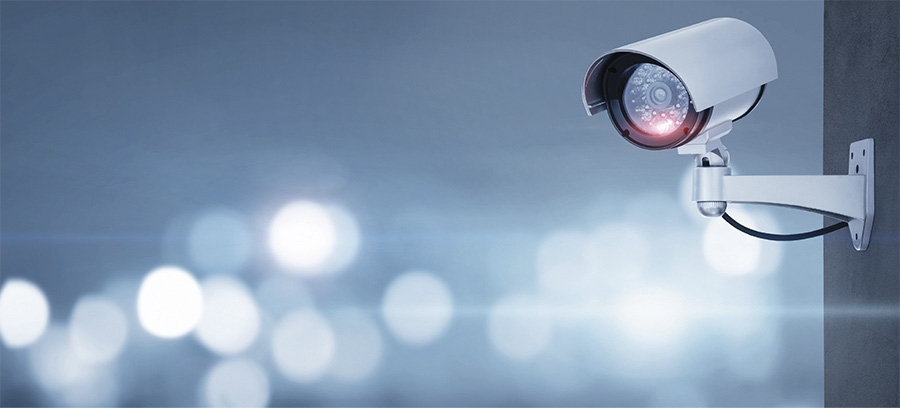
The use of outdoor cameras has seen a massive increase with the rise in video monitoring by government and private security agencies. Courtesy of Laird Thermal Systems.
Because standard thermoelectric devices cannot operate efficiently in high-temperature outdoor applications, spot cooling the imaging sensors in thermal camera applications is no easy task. At high temperatures, materials used in the construction of the thermoelectric device, including solder and copper bus bars, will diffuse into the thermoelectric device. This will cause the standard thermoelectric device to ultimately fail.
Thermoelectric cooler solutions
Next-generation thermoelectric coolers have a robust construction that allows them to survive in harsh-environment applications. Some thermoelectric coolers can operate in temperatures up to 150 °C, exceeding most outdoor applications.
Next-generation thermoelectric
coolers utilize bismuth telluride semiconductor material and thermally conductive aluminum oxide ceramics, which boost cooling capacity by up to 10% compared to traditional thermoelectric coolers. These solid-state heat pumps feature a higher thermal insulating barrier when compared to standard thermoelectric materials, and they improve the temperature differential (ΔT) by up to 5 K. Enhanced thermoelectric materials and rugged construction prevent performance degradation in high-temperature environments, which is a common problem with standard thermoelectric coolers.
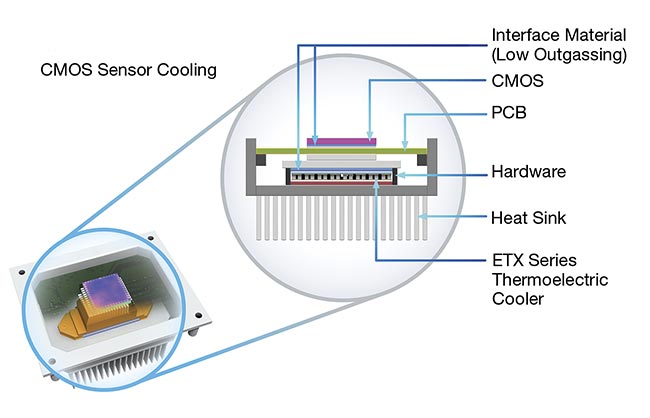
A thermoelectric cooler lowers the temperature of the critical CMOS sensor by as much as ~40 °C from the hot-side temperature of the heat sink. Courtesy of Laird Thermal Systems.
Advanced thermoelectric coolers maintain a high coefficient of performance to minimize the amount of input power required to operate and reduce the heat rejection requirement to the hot side, which is critical in poor heat-sinking applications.
Temperature-sensitive optoelectronics continue to be specified in outdoor thermal camera applications, with worst-case temperatures exceeding 90 °C. Heat fluctuation in these critical systems can cause degradation of performance and even system failure. These cameras require active cooling in order to stay below their maximum operating temperature in outdoor environments and maintain high image resolution. However, standard thermoelectric devices also cannot operate
in these high temperatures. New materials designed for modern, more sophisticated thermoelectric coolers, however, ensure reliable, optimal performance of the heat-sensitive electronics in today’s thermal cameras.
Meet the author
Andrew Dereka is the product director for the thermoelectric cooler and thermoelectric cooler assemblies product lines at Laird Thermal Systems. He has 20 years of thermal management experience working with leading OEMs from around the world, learning about their thermal problems and helping to solve them. Dereka holds an MBA from Rutgers University and a Bachelor of Science in mechanical engineering from the University of North Carolina at Charlotte; email: [email protected].